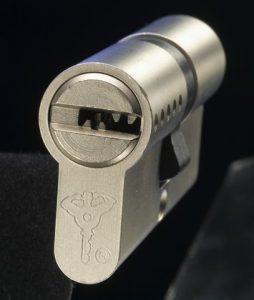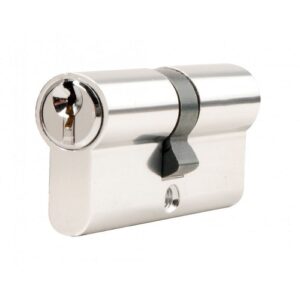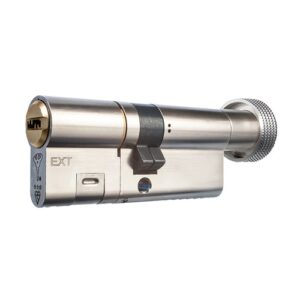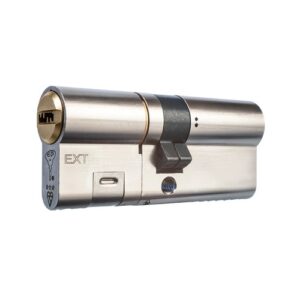13 seconds, some simple DIY tools and a bit of brute strength – that’s all it takes for an intruder to break open a standard Euro cylinder door lock, one of the most common types of door lock found in the UK.
The technique, known as “lock snapping”, is a quick, simple and eerily quiet method that burglars use to gain entry into your home. It is so effective that cases of Euro-cylinder targeted lock snapping account for up to 25% of all burglaries in some counties of the UK, whilst a police force in Greater Manchester said the lock snapping problem was “rife”.
Luckily there is a solution at hand, and it’s one that is available at Door Superstore. Our anti-snap locks have both the coveted TS007 3 star rating and the SS312 Diamond mark in one product, bringing you some much-needed peace of mind.
But how do you know if your front door is vulnerable to the lock snapping in the first place and if it is, how do you change the lock? Our guide to anti-snap door locks will explain all – just read on to find out how you can use them to safeguard your home.
 Table of contents:
Table of contents:
- Is your home at risk?
- What is lock snapping?
- What is a standard Euro cylinder lock?
- Standard Euro cylinder locks vs anti-snap locks
- What kind of anti-snap lock do I need?
- How to fit an anti-snap lock
Burglary statistics – is your home at risk?
Firstly, the good news is that the number of domestic burglaries committed each year has been falling steadily since the 1990s when they reached over 2 million in 1993. However, the Office of National Statistics states that 2 in 100 households could experience burglaries, and in the year ending March 2018, there were still around 650,000 burglaries, of which the majority occurred whilst someone was in the house.
In 67% of the crimes committed, the entry point was a door, with the preferred method of getting through the door being to break the lock itself. This highlights the importance of having a lock that is sturdy enough to resist lock snapping.
What is lock snapping?
Lock snapping is a specific method used by burglars to open doors that are fitted with standard Euro cylinder locks. One of the reasons it is so popular is because it can be carried out silently, unlike smashing windows or bashing indoors.
Burglars essentially snap the Euro lock cylinder in two, by applying a specific amount of force at the weakest part. The handles and any plastic covering are generally removed in order to expose the locking mechanism, which is then gripped with pliers and snapped in two – this can also be done using a professional locksmith tool. (Of course, there is more to it, but we won’t go into too many details in case it becomes a how-to guide for burglars!)
What is a standard Euro cylinder door lock, and do I have one?
If your door is a uPVC, composite or aluminium door installed in the last 15 years, you’re likely to have a Euro cylinder door lock. These locks are generally found on front doors, but can also be found on patio doors, garage doors, side doors and back doors too.
Why are Euro cylinder door locks so vulnerable to lock snapping?
Euro cylinders work with a multipoint locking system, which is the high-security mechanism you’ll find on the edge of the door – it has points that bolt across when the handle is lifted.
Multipoint locks are incredibly secure, but they are only as safe as the cylinder mechanism that controls them. If the cylinder is compromised, the rest of the locking system is useless.
What types of Euro cylinder locks are most high risk?
There are a number of different ratings of door locks, which we will explain below, but unless the cylinder on your door is approved for SS312 Diamond or TS007 3 star rating, your lock could be at risk of snapping.
Standard Euro cylinder locks vs anti-snap locks
The difference between the two types of locks comes down to one tiny hole. In a standard cylinder, the weak spot is the screw hole that is used to attach the lock to the door. If the cylinder is protruding by more than 5mm from the edge of the door, force can be applied to this weak spot, and it will snap and expose the locking mechanism inside.
An anti-snap cylinder has a line cut into the cylinder body, known as a sacrificial snap line, which faces the outside of the door. When force is applied, the cylinder snaps along this line, but the actual mechanism stays intact. Because the lock is in two parts, the door will remain locked even if the front part of the barrel is broken off. Not only will your door lock remain secure, but you can also continue using the lock until you have a chance to replace it.
What kind of anti-snap lock do I need?
Your home will only be secure if the lock meets the following criteria:
SS312 Diamond Standard
“Sold Secure” test a range of door locks to ensure they can withstand the latest methods used by burglars. They work closely with police and insurers, and only once products have been assessed to satisfactory levels can bear their mark. The SS312 Diamond was the first test standard developed, a response to the growing problem of lock snapping, and is still one of the highest levels of security for lock cylinders.
TS007 3 star
If your Euro-cylinder lock bears a TS007 BSI kitemark and a 3-star rating, this indicates that it has been tested for snap resistance, and the kitemark proves that it has been tested by a third party, not just the manufacturer.
What is the best anti-snap door lock?
As stated above, the best anti-snap door locks should have a TS007 3 star rating or an SS312 Diamond Standard rating. However, some locks achieve both of these ratings, such as the anti-snap door locks we sell here at Door Superstore.
We also sell the Mul-T-Lock Breaksure 3DS in three models: the Euro profile, the thumb-turn profile, and the half-turn profile, all of which come with keys that only a recommended locksmith can make. Each lock has a sacrificial end, designed to snap off and leave the locking mechanism intact, and is also drill resistant. Best of all, each Mul-T-Lock Breaksure 3DS lock bears both the TS007 3 star and SS312 Diamond Standard ratings, giving you confidence that they have been tested by third parties to the highest standards possible.
How can I choose the correct Euro-cylinder anti-snap door lock?
All Euro cylinder locks have the same shape, so everyone will fit your door. But they all differ in length, and choosing the correct one is vitally important when it comes to safety.
 The most important thing to do is buy the correct length of cylinder because ideally, you want it to sit flush to the door, with no overhang. It’s vital that the cylinder shouldn’t stick out any more than 3mm from the handle. If it does, burglars will have something to grip onto, making the lock more vulnerable to attack.
The most important thing to do is buy the correct length of cylinder because ideally, you want it to sit flush to the door, with no overhang. It’s vital that the cylinder shouldn’t stick out any more than 3mm from the handle. If it does, burglars will have something to grip onto, making the lock more vulnerable to attack.
Measure your current lock to know the length you require in the new lock (bearing in mind that if the original lock protrudes too much, you’ll need to buy a shorter one). To do this, measure from the centre of the fixing screw to the outside of the lock on both sides.
How to fit a Euro cylinder anti-snap lock
Use our step-by-step guide to fit the lock yourself. Not confident? This is one job you need to get right, so call in the professionals. The Master Locksmiths Association can help you find a qualified locksmith in your area.
- With the door open, unscrew the lock-fixing screw. Loosening the door handle will remove the pressure on the lock, making it easier to remove.
- Turn the key slightly to line the cam tongue up with the main body of the lock. Pull the key gently as you turn, and when the cam tongue lines up, the lock will come out with the key.
- Fit the anti-snap door lock into the hole. Insert with the cam tongue lined up, then move the key slightly to the left and right.
- Screw the lock fixing back into the door, then tighten the door handle screws.
- Ensure the lock works properly by turning the key.
Will not having anti-snap door locks invalidate my home insurance?
All home insurance policies differ so it’s worth checking the small print of your documents just to make sure, but in general, there are no requirements to update your Euro cylinders to anti-snap locks.
But if you live in an area where these kinds of crimes have been reported, it would clearly make good sense to fit anti-snap door locks anyway, regardless of whether you’re told to fit them by your insurers. Burglaries don’t just involve the theft of precious items or valuable cars, they can be emotionally traumatising too. Anti-snap locks can buy you some much-needed peace of mind as well as protection for you and your family.
Do you still have unanswered questions about anti-snap locks or Euro cylinder locks? Don’t hesitate to get in touch and our team will be more than happy to help with advice and product recommendations – just call on 01752 422 501 or use the live chat in the bottom right-hand corner.














